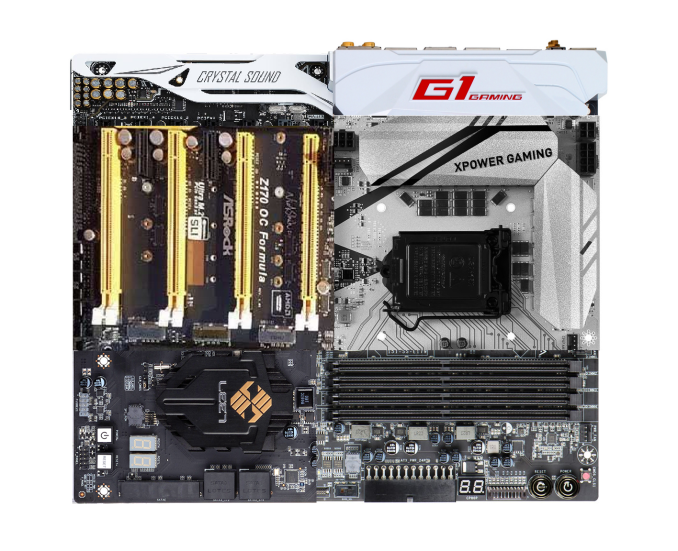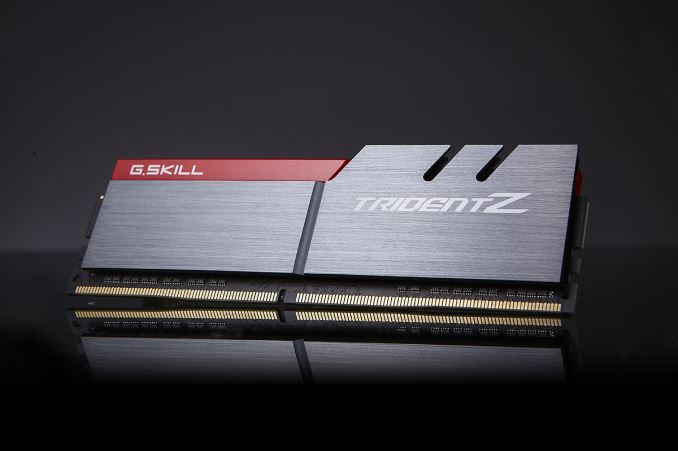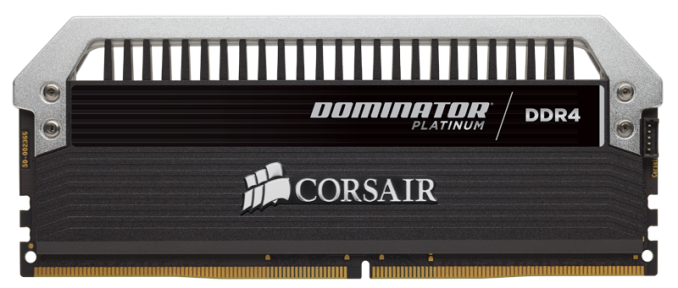The Intel 6th Gen Skylake Review: Core i7-6700K and i5-6600K Tested
by Ian Cutress on August 5, 2015 8:00 AM ESTAlso Launching Today: Z170 Motherboards, Dual Channel DDR4 Kits
The new Skylake processors are assigned a new socket – LGA1151. Intel’s policy since 2006 has been to maintain sockets for two generations and as a result moving from Broadwell to Skylake we were expecting the change. This means that Skylake processors will not work in LGA1150 based motherboards, i.e. those with Intel’s 8th and 9th generation chipsets. For Skylake we get the 100-series chipsets with additional functionality. Launching today in turn is the first member of the 100-series family, the overclocking-friendly Z170, with the other chipsets in the family to follow later in the year.
We have a large piece on the motherboards being released or talked about for Skylake, covering some 55+ products and the different variations within. The major motherboard manufacturers such as ASUS, GIGABYTE, ASRock, MSI, EVGA and a couple of others should all have a wide range ready to purchase on day one, although some models may be region specific.

The badly MSPaint’ed hybrid: MSI’s XPower Gaming Socket, GIGABYTE’s G1 Gaming IO panel, EVGA’s DRAM slots, ECS’s chipset, ASRock’s PCIe arrangement and ASUS’ Deluxe audio.
Here’s an amalgamation of some of the designs coming to end users, with almost all of them investing heavily in gaming brands with specific components to aid the user experience while gaming. Aesthetic designs are also going to be a focus of this generation, with some of the manufacturers moving into a different direction with their designs and trying some new color schemes. Some basic looking models will also be available.
Prices for Z170 motherboards will range from $80 all the way past $400+, depending on feature set and size. A number of motherboards above $150 will feature a couple USB 3.1 Gen 2 (10Gbps) ports, although you will have to check whether they are Type-A or Type-C. That being said, most motherboards with USB 3.1 will use both, but there are a select few that are C-only or A-only. Also over $150 we will see a lot of Intel’s new network controller, the I219-V, although the gaming lines might invest in Rivet Network’s Killer solution instead.
Intel is launching the Alpine Ridge controller at this time as well, which is said to support USB 3.1 Gen 2, Thunderbolt 3, HDMI 2.0, DisplayPort, and DockPort. According to our sources it would seem that GIGABYTE currently has an exclusive on this technology, and it will be used for their USB 3.1 Gen 2 ports on most motherboard models. Other functionality from the Alpine Ridge controller (TB3, HDMI 2.0) will be on a case-by-case basis depending on how the controller works in two different modes or if extra components are used. We are told that Alpine Ridge costs similarly to the ASMedia ASM1142 controller, but will enable two USB 3.1 Gen 2 ports at 10 Gbps simultaneously as it uses four PCIe lanes from the chipset.
We will go more into the 100-series chipset in the next page, but it is worth mentioning briefly here that the speed between the CPU and the chipset has increased from DMI 2.0 (5 GT/s, 2GB/sec) to DMI 3.0 (8 GT/s, 3.93GB/sec), and that the chipset has a new high speed hub (HSIO) that allows 26 lanes to be used from it although some lanes are limited (e.g. 20 PCIe 3.0 lanes maximum split into five x4 controllers). Intel’s Rapid Storage Technology is upgraded as well to give three PCIe drives access to its features as long as they are on the correct HSIO ports.
DRAM: The March to DDR4
In the world of DRAM for personal computers, DDR3 is currently king. Having been the main standard since 2007, you would be hard pressed to find a mainstream or low end platform sold that did not require access to DDR3. That changed in the enthusiast segment last year with the launch of Haswell-E which also introduced DDR4 at a high premium. For Haswell-E there was no crossover – you had no choice but to use DDR4 (unless you might be a million-unit customer).
Because the consumers and consumer product OEMs are more price sensitive, DDR4 will be a slower transition. There is precedent here in that the move from DDR2 to DDR3 saw a generation of processors that supported both standards and it was up to the motherboard manufacturer to design for it. In this transition, Skylake processors will support both DDR3L and DDR4 modules, with a few caveats.
Caveat number one is that initially, only DDR4 motherboards will be on the market. So if you upgrade now, DDR4 needs to be on the shopping list as well. We have had word of some DDR3L-only motherboards coming, as well as combo boards with DDR3L and DDR4 slots on board. Caveat one-point-five, you can use either DDR3L or DDR4, but not both at the same time.
Caveat number two, DDR3L is different to DDR3 as it operates at a lower voltage. This means that the memory controllers on Skylake most likely have a combined voltage domain, and regular DDR3 might not work (in fact early testing suggests not without reducing the voltage). Very few people currently own DDR3L DIMMs, so the likelihood of a user performing an upgrade while reusing their RAM might be slim.
Caveat number three: prices of DDR4 have dropped significantly since last year, and there is only a small premium over DDR3. The benefits of DDR4 include a lower operating voltage, a more stable design, and the ability to purchase 16GB modules with ease. That means that a Skylake platform will happily take 64GB of memory.
With that last point, we should point out that Skylake is a dual memory channel architecture, supporting two memory modules per channel. This gives a maximum of four DDR4 tests, and 4x16 = 64GB maximum.
We have been told that Skylake’s memory controller, compared to previous generations, is absolutely golden at higher speed memory support. By default Skylake supports the JEDEC standard for DDR4, 2133 MT/s at a latency of 15-15-15, but the overclocking guides we have received suggests that all processors should be able to reach DDR4-3200 relatively comfortably, with a few processors in the right motherboards going for DDR4-4000. While this should bode well for integrated graphics users, those high end kits are typically very expensive.
We currently have dual channel kits in to test from a number of the DRAM companies, and plan on performing a memory scaling article within the next few weeks to see how exactly performance might scale on Skylake. Though in the meantime, as part of this review, we were able to source a closed beta variant of a combination DDR3L/DDR4 motherboard for Skylake and have included a test comparing the two.












477 Comments
View All Comments
Sttm - Wednesday, August 5, 2015 - link
Glad to see that my 2600k is still on par for gaming; because this means I wont be tempted to buy a CPU from a company that would pay their employees $4000 not to hire someone because they have the same skin color as me, the same gender.Hopefully AMD will come out with a good CPU upgrade for me next year, and I can skip buying from Racist/Sexist Intel.
repoman27 - Wednesday, August 5, 2015 - link
I posted this earlier, but it seems to have disappeared along with the comment it was a reply to. Is there some filtering going on in the comments section these days?It's annoying that Anandtech is continuing to make things confusing for everyone by deciding to call USB 3.1 SuperSpeed devices USB 3.0. We don't refer to USB 2.0 keyboards that only operate at 12 Mbit/s USB 1.0 or even USB 1.1. The problem is with the common practice of using the specification revision number as a stand-in for the maximum supported data transfer mode. Since USB's inception, their have been ordained names for the transfer modes that were supposed to be used in public facing marketing materials but everyone pretty much ignored them (Low Speed, Full Speed, High Speed, SuperSpeed, and SuperSpeedPlus).
The USB 3.1 specification supersedes the USB 3.0 spec. Just as with HDMI, DisplayPort, or any number of other standards, not all features are required to be compliant with a given version. However, as soon as you include any feature that only appears in a newer revision, you either have to roll with that spec or be considered a non-compliant implementation.
Using Apple as an example, although they did not include a discrete USB 3.1 host controller in the MacBook (Retina, 12-inch), they did make use of the USB Type-C Cable and Connector Specification, Billboard Device Class Specification, USB Power Delivery Specification Revision 2.0, and USB Type-C Alternate Modes including the DisplayPort Alternate Mode. While those features are all technically outside the scope of the actual USB 3.1 spec, using USB Type-C ports raises the minimum current carrying capacity to 3.0 A, which in turn requires slightly elevated VBUS voltages to account for increased losses. The VBUS supply of the new MacBook runs at up to 5.5 V DC instead of the previous limit of 5.25 V DC to ensure voltage levels are within a suitable working range at the device end. The result of this is that the USB port on the new MacBook is fully USB 3.1 compliant despite only supporting SuperSpeed or Gen 1 operation, but is not actually compliant with the original USB 3.0 specification.
If an OEM is using USB 3.1 Gen 1 in lieu of USB 3.0 to trick people on spec sheets, then yes, it's scummy. If their implementation is such that it qualifies as USB 3.1 but not USB 3.0, then it's merely the correct way of describing it.
Ryan Smith - Wednesday, August 5, 2015 - link
"I posted this earlier, but it seems to have disappeared along with the comment it was a reply to. Is there some filtering going on in the comments section these days?"Nope. That's my fault. I deleted the placeholder comment I had put in this morning about catching up on the graphs. I forgot that deleting a root comment also sends its children off to the void. Sorry about that.
Wolfpup - Wednesday, August 5, 2015 - link
Huh. The IPC increase over Broadwell is surprisingly lame. Looking at all this, Haswell was actually a better upgrade than I’d realized.I’d sort of thought the team doing Conroe/Penryn/Sandy/Ivy/Skylake was better than the other team…but I guess that’s not universally true, and really Haswell is a better CPU than I’d realized. I mean not that I thought it was BAD, I just didn’t realize it was as much better over Ivy Bridge as it is.
I’m pleasantly surprised by how big a jump there is going from Sandy Bridge to Skylake. In one thing I actually use, we’re talking about a 70% increase at the same clock speed! That’s seriously impressive, and I bet a lot of people will be upgrading from Sandy Bridge.
I’ve got Ivy Bridge and Haswell in my main systems, and they’re certainly just fine, but it’s nice to see things are improving!
Of course then I get to the gaming page, and…honestly it looks like if you’ve got Sandy Bridge, you’re fine, so long as you’re using a dedicated GPU.
Kind of surprised by how decent Intel’s GPUs are now, though they still tick me off as I still want those transistors used on larger CPUs or more cores!
Gich - Wednesday, August 5, 2015 - link
I'd like to change my Z68 MoBo for a Z170 while keeping my i5 2500k.zlandar - Wednesday, August 5, 2015 - link
I also do not understand why Sandy Bridge's time is "up". Who sits around running synthetic benchmarks all day? Maybe if you use your computer for alot of video processing it makes sense. The majority of people who care are going to be gamers and the bottleneck remains GPU not CPU.That kind of statement should be reserved for a cpu release that would make me upgrade my current system now.
Achaios - Wednesday, August 5, 2015 - link
You are wrong. Yet another guy who has got no clue about gaming. There are games that depend almost completely on single threaded performance. World of Warcraft, Total War series games, Starcraft II, to name a few.The performance gain in those games (and other CPU bound games) over Sandy Bridge is well worth the upgrade.
Sttm - Wednesday, August 5, 2015 - link
Until they get a DX12 client, at which point that CPU bottleneck evaporates.Achaios - Wednesday, August 5, 2015 - link
DX 12 will not help in Single Threaded (CPU bound) games at all.mdriftmeyer - Wednesday, August 5, 2015 - link
Nice Red Herring. No one is debating the past. They are discussing with Mantle/DirectX 12/Vulkan, those that declare themselves certified for the features touted by such will mean Single Threaded Games are of the past and moving forward implementing your DX12/Vulkan games into the core engine infers multi-core evenly distributed resource management.